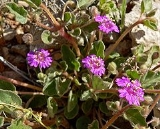
Allionia
Encyclopedia
Allionia, commonly known as windmills or trailing four o'clock, is a genus
of two species widespread in the western hemisphere. They are unusual in their blooms, which actually consist of three separate flowers appearing to be a single flower.
The plants are finely pubescent annuals or short-lived perennials, with trailing stems up to a metre in length, often threading through other vegetation. The leaves range from oval to oblong, under 4 cm long. The inflorescences are axillary
, consisting of three red-purple flowers symmetrically arranged and superficially seeming to be a single flower 3-15 mm across. The individual flowers are bisexual, bilaterally symmetric, with a distinct oblique funnel. The 5-7 stamen
s may be somewhat exserted, along with the style
. The fruits have five ribs.
The range of Allionia incarnata L. includes North America
, the West Indies, Central America
, and South America
, while Allionia choisyi Standley is more restricted in North America, occurring in Arizona
, Utah
, New Mexico
, and Texas
.
The two species can be only be reliably distinguished by characteristics of their fruits, and even those may be found intergraded where the species' ranges overlap.
Linnaeus named the genus after Italian botanist Carlo Allioni
(1725-1804).
Genus
In biology, a genus is a low-level taxonomic rank used in the biological classification of living and fossil organisms, which is an example of definition by genus and differentia...
of two species widespread in the western hemisphere. They are unusual in their blooms, which actually consist of three separate flowers appearing to be a single flower.
The plants are finely pubescent annuals or short-lived perennials, with trailing stems up to a metre in length, often threading through other vegetation. The leaves range from oval to oblong, under 4 cm long. The inflorescences are axillary
Axillary
Axillary means "related to the axilla "."Axillary" may refer to:* Axillary artery* Axillary vein* Axillary nerve* Axillary bud...
, consisting of three red-purple flowers symmetrically arranged and superficially seeming to be a single flower 3-15 mm across. The individual flowers are bisexual, bilaterally symmetric, with a distinct oblique funnel. The 5-7 stamen
Stamen
The stamen is the pollen producing reproductive organ of a flower...
s may be somewhat exserted, along with the style
Gynoecium
Gynoecium is most commonly used as a collective term for all carpels in a flower. A carpel is the ovule and seed producing reproductive organ in flowering plants. Carpels are derived from ovule-bearing leaves which evolved to form a closed structure containing the ovules...
. The fruits have five ribs.
The range of Allionia incarnata L. includes North America
North America
North America is a continent wholly within the Northern Hemisphere and almost wholly within the Western Hemisphere. It is also considered a northern subcontinent of the Americas...
, the West Indies, Central America
Central America
Central America is the central geographic region of the Americas. It is the southernmost, isthmian portion of the North American continent, which connects with South America on the southeast. When considered part of the unified continental model, it is considered a subcontinent...
, and South America
South America
South America is a continent situated in the Western Hemisphere, mostly in the Southern Hemisphere, with a relatively small portion in the Northern Hemisphere. The continent is also considered a subcontinent of the Americas. It is bordered on the west by the Pacific Ocean and on the north and east...
, while Allionia choisyi Standley is more restricted in North America, occurring in Arizona
Arizona
Arizona ; is a state located in the southwestern region of the United States. It is also part of the western United States and the mountain west. The capital and largest city is Phoenix...
, Utah
Utah
Utah is a state in the Western United States. It was the 45th state to join the Union, on January 4, 1896. Approximately 80% of Utah's 2,763,885 people live along the Wasatch Front, centering on Salt Lake City. This leaves vast expanses of the state nearly uninhabited, making the population the...
, New Mexico
New Mexico
New Mexico is a state located in the southwest and western regions of the United States. New Mexico is also usually considered one of the Mountain States. With a population density of 16 per square mile, New Mexico is the sixth-most sparsely inhabited U.S...
, and Texas
Texas
Texas is the second largest U.S. state by both area and population, and the largest state by area in the contiguous United States.The name, based on the Caddo word "Tejas" meaning "friends" or "allies", was applied by the Spanish to the Caddo themselves and to the region of their settlement in...
.
The two species can be only be reliably distinguished by characteristics of their fruits, and even those may be found intergraded where the species' ranges overlap.
Linnaeus named the genus after Italian botanist Carlo Allioni
Carlo Allioni
Carlo Allioni was an Italian physician and professor of botany at the University of Turin. His most important work was Flora Pedemontana, sive enumeratio methodica stirpium indigenarum Pedemontii 1755, a study of the plant world in Piedmont, in which he listed 2813 species of plants, of which 237...
(1725-1804).

